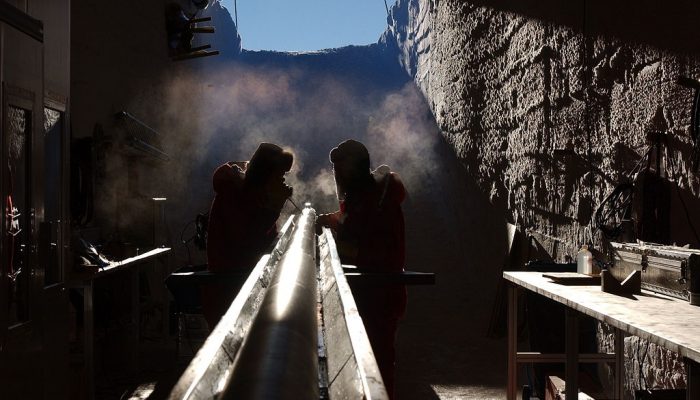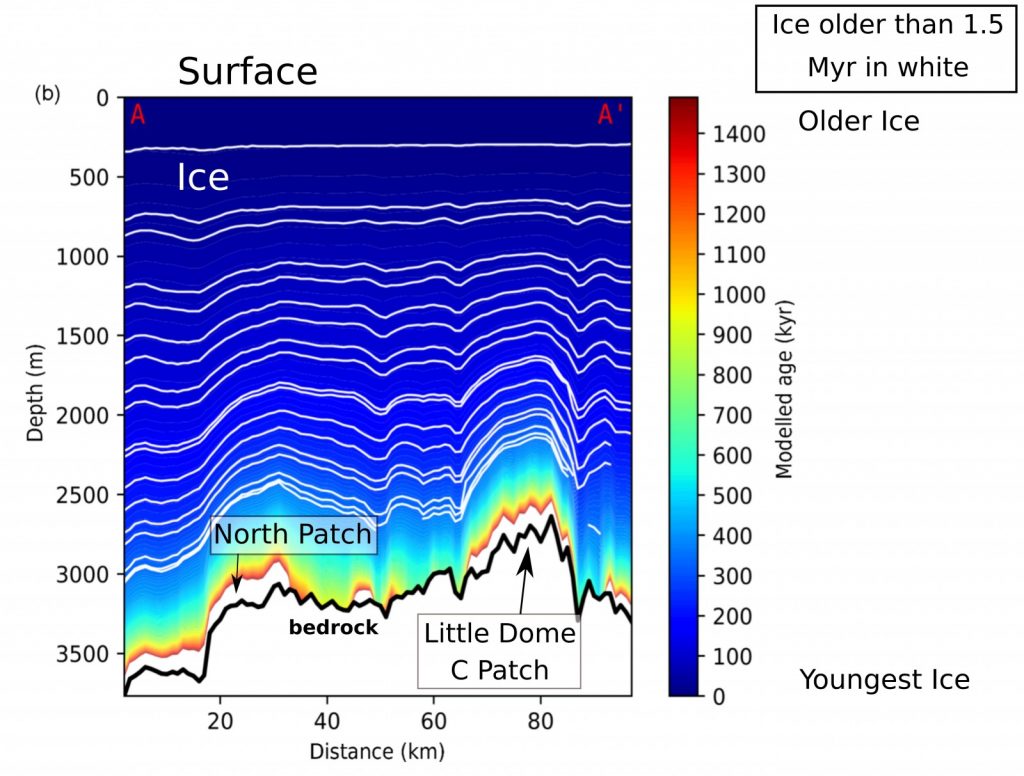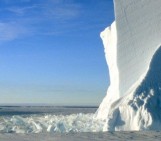
The thick packs of ice that pepper high peak of the world’s mountains and stretch far across the poles make an unusual time capsule. As it forms, air bubbles are trapped in the ice, allowing scientists to peer into the composition of the Earth’s atmosphere long ago. Today’s Geosciences Column is brought to you by PhD researcher Ruth Amey, who writes about recently published research which reveals how a team of scientists might have found the oldest ice yet, which has important implications for our understanding of how Earth’s environment has changed over time.
Ice cores give us a slice through the past. By analysing the composition of ice and gas bubbles trapped within it, we can find out information about temperature, atmospheric conditions, deposition and even the magnetic field strength of the past.
This helps us to understand past conditions on the Earth, but currently the longest record is ~800,000 years (800 kyrs) old. One phenomenon scientists hope to understand better is a change in glaciation cycles. During the Mid-Pleistocene Transition, glaciation cycles changed from 40,000 year cycles related to the obliquity periodicity of the Earth’s orbit to longer, stronger 100,000 year cycles. Scientists of the ice-core community have their eyes on finding out why this change happened, and for this they need data from the onset of the change, between 1250 and 700 kyrs ago.
Which means we need much, much older ice.
A new study, published in EGU’s open access journal The Cryosphere has pinned down two locations where they think the base of Antarica’s ice sheet is significantly older. In fact they believe the ice could be as old as 1.5 million years, which would extend the current ice core record by ~700,000 years: nearly doubling it.
A Treasure hunt – using airborne radar and some simple models
The group, led by Frederic Parrenin at University of Grenoble Alpes, France, went on the hunt for the oldest ice East Antarctica could give them. The survival of ice is an interplay between many factors: the ice acts a little bit like a conveyor belt, being fed by accumulation, with the oldest information lost off the end by basal melting. This means areas of thinner ice, where there is less basal heating, often has a higher likelihood of the old, information-rich ice surviving.

Figure 2: A cross-section of ice in East Antarctica, from surface to bedrock, with colour bar showing the modelled ice age. The model identifies two patches of ice older than 1.5 Myr (shown in white): North Patch and Little Dome D Patch. Adapted from Figure 3 of Parrenin et al 2017.
Airborne radar can ‘see’ into the top three-quarters of the East Antarctica ice sheet. By identifying reflections within it, isochrones of ice of the same age can be traced. Parrenin’s group exploited an area in East Antarctica known as ‘Dome C’ with rich record of radar investigations. Using information derived from the radar, they then created a mathematical model, which balanced accumulation rate, heat flow and melting to give a simple 1-D ice flow model. This helps locate areas of accumulation and melting, which gives an indication of where ice might be the oldest, beyond the sight of the airborne radar. A nearby ice-core, EDC, also provided corroboration of their model.
X Marks the Spot
The team located two sites where they believe the ice to be older than 1.5 million years old, named Little Dome C and North Patch. And fortunately these sites are within a few tens of kilometres from the Concordia research facility, meaning drilling them is a real possibility.
This ancient ice could give vital insight into what happened in the Mid-Pleistocene Transition. What caused the new glaciation cycle onset? Was it a change in sea ice extent? A change in atmospheric dust? Decrease in carbon dioxide concentrations? Changes in the Earth’s orbit? The answers may well be locked in the ice.
By Ruth Amey, Postgraduate Researcher at the University of Leeds
References and Resources
Parrenin, F., Cavitte, M. G. P., Blankenship, D. D., Chappellaz, J., Fischer, H., Gagliardini, O., Masson-Delmotte, V., Passalacqua, O., Ritz, C., Roberts, J., Siegert, M. J., and Young, D. A.: Is there 1.5-million-year-old ice near Dome C, Antarctica?, The Cryosphere, 11, 2427-2437, https://doi.org/10.5194/tc-11-2427-2017, 2017
Berger, A., Li, X. S., and Loutre, M. F.: Modelling northern hemisphere ice volume over the last 3 Ma, Quaternary Sci. Rev., 18, 1–11, https://doi.org/10.1016/S0277-3791(98)00033-X, 1999
Imbrie, J. Z., Imbrie-Moore, A., and Lisiecki, L. E.: A phase-space model for Pleistocene ice volume, Earth Planet. Sc. Lett., 307, 94–102, https://doi.org/10.1016/j.epsl.2011.04.018, 2011
Jean Jouzel, Valérie Masson-Delmotte, Deep ice cores: the need for going back in time, In Quaternary Science Reviews, Volume 29, Issues 27–28, Pages 3683-3689, ISSN 0277-3791, https://doi.org/10.1016/j.quascirev.2010.10.002, 2010
Martínez-Garcia, A., Rosell-Melé, A., Jaccard, S. L., Geibert, W., Sigman, D. M., and Haug, G. H.: Southern Ocean dust-climate coupling over the past four million years, Nature, 476, 312–315, doi:10.1038/nature10310, 2011
Tziperman, E., and H. Gildor, On the mid-Pleistocene transition to 100-kyr glacial cycles and the asymmetry between glaciation and deglaciation times, Paleoceanography, 18(1), 1001, doi:10.1029/2001PA000627, 2003
Wessel, P. and W. H. F. Smith, Free software helps map and display data, EOS Trans. AGU, 72, 441, 1991




